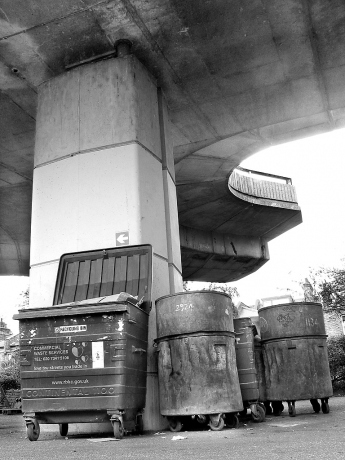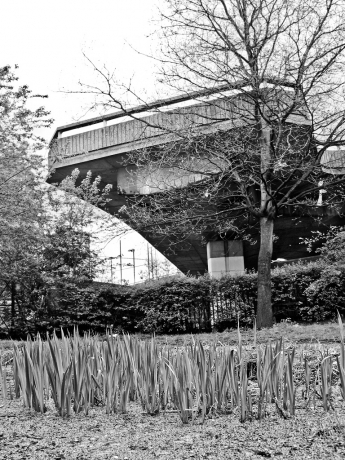Each day my walk to work would take me under the Westway. Four times a day I’d hurry past the incongruous stables with their riding lessons. Four times a day (yes, four times – it seemed somehow genteel to retire home for lunch… if there can be any gentility in swallowing down Marmite on toast in a mouse-infested kitchenette) past the white, bulbous sports hall that pressed against the bottom of the flyover like a balloon stuck under a chair. And I became used to the gloomy, swooshing, subterranean stillness.
The swooshing is from the traffic hurtling in three directions above: down to the Shepherd’s Bush water tower or, on its impossibly high elevation, east towards the West End or west to High Wycombe. The stillness is harder to account for. For a shadowed patch of concrete-hemmed footpaths under a big motorway junction, it’s peculiarly busy. Mainly people walking dogs. But often film crews, with gaffer-taped wires and luxury coaches, tucking into sandwiches by humming generators in the long breaks while graffiti-tagging their TV ads with gritty urban realism. But even then there is a stillness. The stillness of pressing pause on CCTV footage. Maybe it just seems still by comparison with the noises of motion above.
I’d been walking this way for months with no real incidents, other than having my trousers ripped off me by a stray dog. But then one lunchtime I looked up and noticed it: jutting out from one side of the Northern Roundabout (rather a jumped-up name for a congealed lump of slip roads), a little spur of concrete. A truncated exit, that led not to free-flowing, grade-separated utopia, but to a spot in mid-air, just over the roof of a house on Oxford Gardens.
I stood, gawping, transfixed, enjoying the appropriately geometric soundtrack of the second side of Heroes that my iPod was kindly providing. Why was it there, squared-off but menacing? Was it a town-planning version of the little yellow plastic jumps you used to get in Scalextric, a witty Friday afternoon architectural joke left in for private amusement? Then the echoed barks of another stray dog broke through my retro-futurist reverie, and I scampered back to work.
But my heart was still there beneath the Northern Roundabout. In times past I would have had to dally listlessly with my afternoon’s toil, distracted by visions of set-square-crisp carriageways and cutaway diagrams of drainage systems, and by plans for trips to the records office. Luckily, it was the early 2000s. Google was there to quench my historical thirst.
It was a motorway. Or was once meant to be. One that would have stretched from the river to the M1, and then round a whole city-manacling circuit of similar pre-cast gaugings. The London Motorway Box. A high-flying lap of the city, with slip roads. This particular piece would have flown or carved through much of West London, even leaping over the Earl’s Court exhibition halls. I emitted a tender gasp of Brutalist desire. It would have delivered on the Northern Roundabout’s nominal grandeur, if rendering the name rather inaccurate in the process. It was like Syd Barrett – cut down before its prime.
The more I learnt of its path, the more I could see it. See it on my journey home. See it next to me, chopping its low-slung way along Latimer Road. See its web of slipways where PR companies now lived. I could even see it rocketing by the counter at Mick’s Fish Bar on the corner of North Pole Road – and no doubt being given the same suspicious glance as any unknown customer.
I began to take long walks that followed its ghostly outline, and each day I could see more of it. I looked at the new industrial units, keeping its place warm next to the railway line, and at the smug Edwardian red bricks on the other side of the street, ignorant of their lucky reprieve. Each day I looked harder. Unless it was raining, then I just sulked. Eventually, I plucked up the courage to tell someone about my obsession. My flatmate. After last orders at the North Pole, at a table that, by rights, should have been under the southbound hard shoulder. As he came back from the toilet and lit a cigarette, I blurted out:
“We’re sitting on a motorway!”
He raised his eyebrow, sucking pensively on his Camel. This was not the first unexplained outburst in our fifteen-year friendship.
“What?”
“Here! Right here! There was going to be one. This is where the West Cross Route would’ve gone.”
Unable to control myself I spewed out details. He looked curiously unmoved – until I got to the bit about a six-lane motorway arching over Earl’s Court.
“But that would’ve been awful. Imagine how disgusting it would be now.”
I wanted to retort that the view of North Pole Road outside was hardly one Griff Rhys Jones would lift a cheek to save. But he had a point. As had had the Homes Not Roads campaign, when they’d helped get the London Motorway Box filed away forever in the early 1970s. After the fierce campaigning when the Westway itself was opened, no one wanted to take the political heat for tearing up yet more voters’ homes in pursuit of the future.
I realised that I had been visualising the Motorway Box as the planners had: as empty tarmac, shining in the lunchtime of a blessed June Wednesday. Like the M1 in old pictures of its opening day, only in London, and in colour – Allegro yellow and Escort blue. Glossy and modern. Somehow, I’d been seeing it like this despite my daily observance of its amputated limb in a state of rain-scarred grimness.
But I wasn’t pining for the road that hadn’t been built. Far from it, the last thing this bit of town needed was more broken seventies bric-a-brac – even if what was there had come in useful for shooting the cover of The Jam’s This Is The Modern World and the video for Blur’s For Tomorrow. I didn’t really want it to be there at all. I was just smitten with the idea of the idea. Of super-efficient super-highways carrying Letraset Hillman Minxes to their self-important blueprint destinations. Destinations, no doubt, full of concrete overhead walkways and pre-stressed shopping courtyards. It was a yearning for what could never have been, for the thick-nibbed optimism that had produced the plan – and maybe also for the streams of lorries in the slow lane that would have quickly curbed W10’s stray dog problem.
So while I continued to conjure up the route on my daily walks – and even, gingerly, late at night, on very long round trips to the corner shop – I was happy it was just in my head. My motorway. My secret motorway, being privately efficient and never snarled up. A glimmering snapshot of an abandoned future, forever depicting a sunny midday heat haze over North Kensington.
[This piece originally appeared in Smoke 12.]



